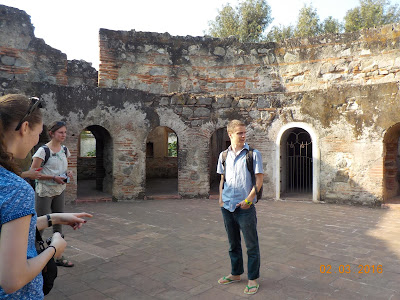February 3.
Consecrated in 1736, el Convento de las Capuchinas was the first in Guatemala that didn't require money from its nuns. All the other convents required dotes, literally "dowry." This meant that only women from rich families could become nuns, and effectively made de las Capuchinas the first to accept indigenous women.
There was room for 25 nuns, who led a contemplative and cloistered life. After joining the order, a nun would never see her family or the outside world again. Even after death, her family wasn't permitted to see the body. A "graduated" nun was buried under the chapel with a crown of white roses and a ring that symbolized her marriage to God (while alive, she was engaged). Their tiny cells had the barest of furniture, they spent days at a time praying (I know, "pray without ceasing," but days), and were guarded closely by the mother superior. So why become a nun? Our friendly tour guide, who was a real nerd about architecture, gave us two reasons. If you were rich and embarrassed your family, sending you to a nunnery to keep you out of the public eye was a viable option. If you were poor and systematically oppressed, this was an opportunity for education, (relative) comfort, and to always know where your next meal would come from.

Our guide told us that the construction of the convent and chapel of Capuchinas was designed with a mix of Maya and European influences. I'm not sure whether the inclusion of Maya themes was deliberate or just came about because of the surrounding culture.
All of the other colonial chapels in Antigua are orientated north-south, las Capuchinas is east-west. The little window in the back illuminated the alter with the rising sun. The sun is a Big Deal in Maya cultures.
The design implemented a lot of circles and arcs, as you can see in chapel. Circles represent perfection and infinity. In the Maya fire ceremony a circle is drawn to ask permission (of the earth or of the gods, I'm not sure) to perform the ritual. In Spanish architecture, the square was the favorite shape. Arabic influence on Spain brought the octagon, another shape of perfection.

This fountain, as well as the one in the central park of Antigua, makes use of all three perfect shapes. The Arabic octagon, the European square, and the Maya circle.
The cross also has a Maya significance. The symbol existed in Central America before the conquista. The four points correspond with the four cardinal directions, the four colors of corn, and a person's four grandparents.
This is what facebook looked like, back in the day.
The kitchen. The stove is called a poyo because the servants would lean on the wide edge, from the verb apoyar, "to support." It has nothing to do with chicken.
"Don't sit on the archaeological pieces!"
The nuns' only communication with the outside world came by way of a Lazy Susan in the wall to receive letters, gifts, and meals. This one connected the kitchen to the convent, the nuns never even saw their servants. In the chapel wall next to the alter is a little grated window for them to receive the Eucharist. There is also a special corridor where a nun could visit her family on the other side of a door. The corridor was curved in an L shape so the mother superior could secretly stand behind the nun and hear everything.
That's a door, a door post, and a hinge made out of a chain.


Our guide stressed that these ladies lived in comfort. They had hot water, bathtubs, and a sauna equipped with an arm rest to help with meditation.
On the left is a toilet.
The main feature of the convent is the round tower. If you stand on the tile in the exact center your voice echoes back at you, which is pretty cool. Around the circumference are little cells where the nuns might spend days at a time praying.
On the outside of the tower you can see holes that were chimneys for the candles in the little cells. Our guide was very excited about the triangle that sticks out above the chimney hole, to keep rain water from falling inside.
Underneath the tower is a round basement with incredible acoustics for singing. Our group is blessed with a singing professor and two choir members, and you can bet we took advantage of that.
This concludes the long overdue Antigua series. Maybe soon you'll see pictures of Nicaragua.














